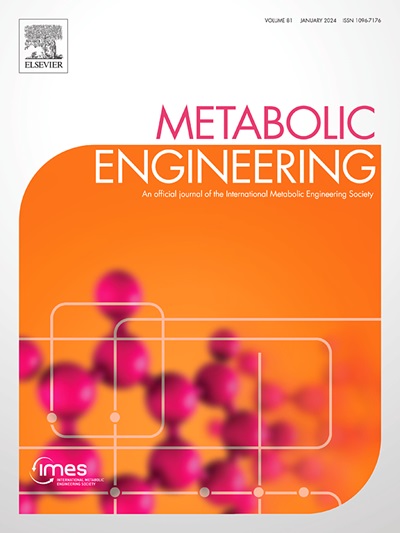Engineering a novel pathway for efficient biosynthesis of salicin in Escherichia coli
IF 6.8
1区 生物学
Q1 BIOTECHNOLOGY & APPLIED MICROBIOLOGY
引用次数: 0
Abstract
Salicin is a natural glycoside compound widely used to treat fever, inflammation, and analgesia. Currently, salicin is primarily extracted from willow bark, which is not only cumbersome in terms of extraction and separate steps, but also subject to seasonal and geographic limitations. In this study, a highly efficient biosynthetic pathway for salicin synthesis was designed and constructed in E. coli. The most important precursor in the synthetic pathway of salicin designed in this study is salicyl alcohol. Building on a previously constructed biosynthetic salicylic acid metabolic pathway, the production of salicyl alcohol in shake flask fermentation reached 1.7 g/L by increasing the supply of shikimic acid pathway precursor PEP and salicyl alcohol precursor chorismate. According to the principle of substrate similarity, this study identified the key enzyme OsSGT1 from Oryza sativa, which uses E. coli endogenous UDP-glucose as a glycosyl donor to glycosylate salicyl alcohol into salicin. By redefining the optimal substrate of OsSGT1, and balancing metabolic flux along with increasing the supply of UDP-glucose, salicin production in shake flasks reached 4 g/L. Finally, culturing the high-yield strain in a 3-L fermenter resulted in the synthesis of 14.62 g/L of salicin. To the best of our knowledge, this achievement marks the highest salicin production through microbial fermentation to date.
在大肠杆菌中设计一条高效生物合成水杨素的新途径。
水杨素是一种天然苷类化合物,广泛用于治疗发烧、炎症和镇痛。目前,水杨素主要从柳树皮中提取,不仅提取和分离步骤繁琐,而且受到季节和地域的限制。本研究在大肠杆菌中设计并构建了一条高效合成水杨素的生物合成途径。本研究设计的水杨素合成途径中最重要的前体是水杨醇。在之前构建的水杨酸生物合成代谢途径的基础上,通过增加莽草酸途径前体 PEP 和水杨醇前体胆氨酸的供应,摇瓶发酵中水杨醇的产量达到了 1.7 g/L。根据底物相似性原理,本研究确定了大麦中的关键酶 OsSGT1,它以大肠杆菌内源 UDP-葡萄糖为糖基供体,将水杨醇糖基化为水杨素。通过重新确定 OsSGT1 的最佳底物、平衡代谢通量以及增加 UDP 葡萄糖的供应,摇瓶中的水杨素产量达到了 4 克/升。最后,在 3 升发酵罐中培养高产菌株,合成了 14.62 克/升的水杨素。据我们所知,这是迄今为止通过微生物发酵生产水杨素的最高产量。
本文章由计算机程序翻译,如有差异,请以英文原文为准。
求助全文
约1分钟内获得全文
求助全文
来源期刊

Metabolic engineering
工程技术-生物工程与应用微生物
CiteScore
15.60
自引率
6.00%
发文量
140
审稿时长
44 days
期刊介绍:
Metabolic Engineering (MBE) is a journal that focuses on publishing original research papers on the directed modulation of metabolic pathways for metabolite overproduction or the enhancement of cellular properties. It welcomes papers that describe the engineering of native pathways and the synthesis of heterologous pathways to convert microorganisms into microbial cell factories. The journal covers experimental, computational, and modeling approaches for understanding metabolic pathways and manipulating them through genetic, media, or environmental means. Effective exploration of metabolic pathways necessitates the use of molecular biology and biochemistry methods, as well as engineering techniques for modeling and data analysis. MBE serves as a platform for interdisciplinary research in fields such as biochemistry, molecular biology, applied microbiology, cellular physiology, cellular nutrition in health and disease, and biochemical engineering. The journal publishes various types of papers, including original research papers and review papers. It is indexed and abstracted in databases such as Scopus, Embase, EMBiology, Current Contents - Life Sciences and Clinical Medicine, Science Citation Index, PubMed/Medline, CAS and Biotechnology Citation Index.
 求助内容:
求助内容: 应助结果提醒方式:
应助结果提醒方式:


